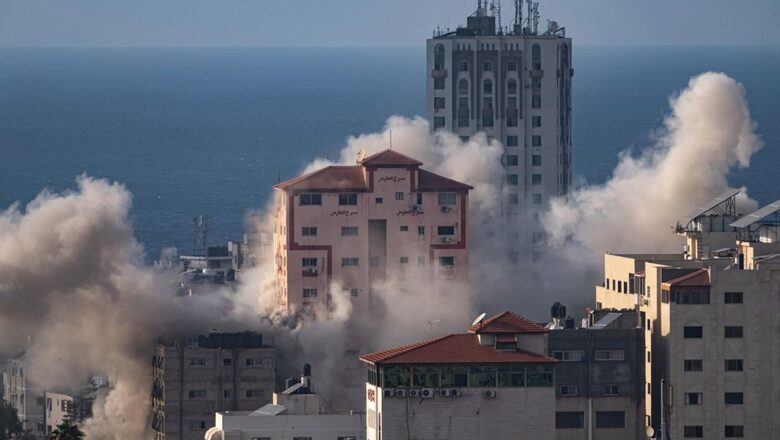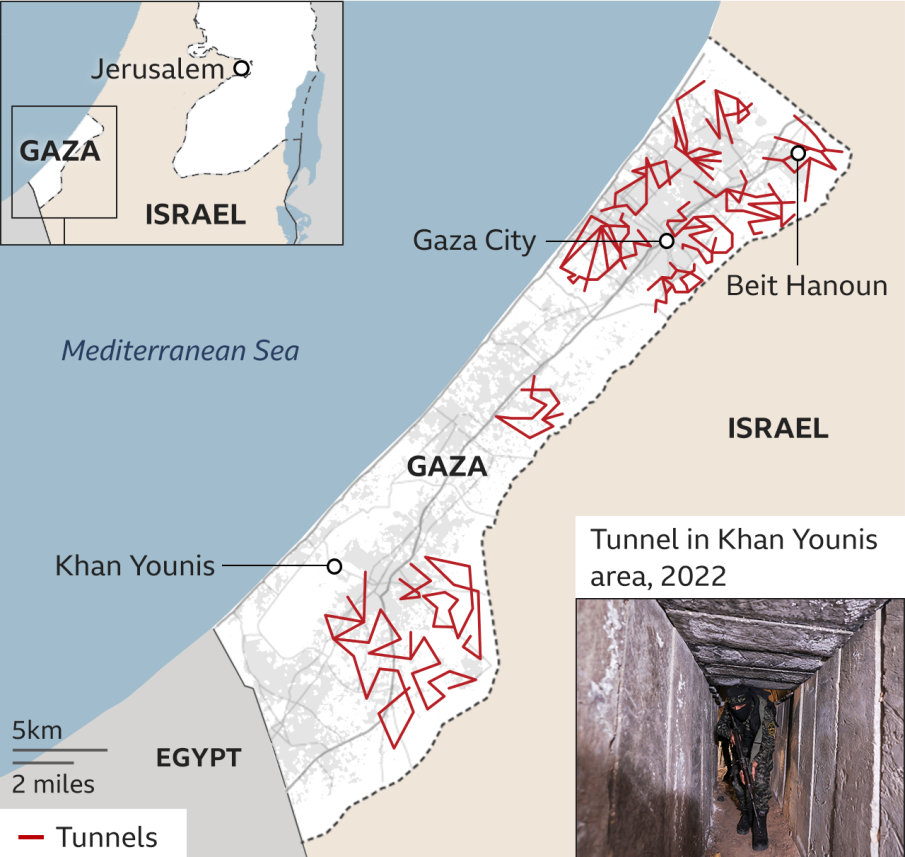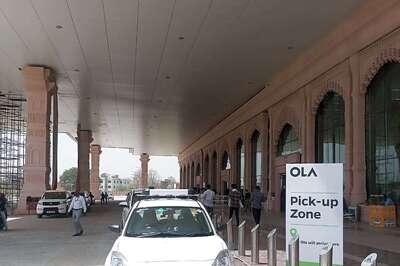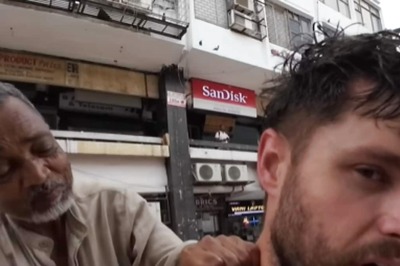
views
Immediately after the October 7, 2023 surprise Hamas attack on Israel, the Israeli Air Force (IAF) was pressed into action, pumping precision munitions on Hamas targets across the entire Gaza Strip and elsewhere. The IAF is universally recognised to be among the world’s most powerful aerial fighting forces. It remains the central pillar of the Israeli Defence Forces (IDF) and has played a major role in deterring terrorist threats and securing the country’s numerous military victories. It is a third of the total IDF strength.
In the last few days, the IDF has begun land incursions, sending tank columns into Gaza and firing at targets from a distance. The aim is to break Hamas’ defensive perimeter around its main bunkers and tunnels in Gaza City. The city has been cut off from the north, south and the sea coast. Meanwhile, the air campaign carries on relentlessly as the primary offensive means.
Israeli Air Force – Major Air Action
The IAF began seeing action very early after it was formed in 1948. It played an important part in the 1956 Suez Crisis, dropping paratroopers at the Mitla Pass. In the 1967 Six-Day War, the IAF incapacitated the opposing Arab air forces and attained air supremacy for the rest of the war. Subsequently, the IAF kept engaged in repeated bombings of strategic targets deep within enemy territory as part of the war of attrition. In the Yom Kippur War of 1973, the IAF was initially on the defensive and Israel had to first neutralise the missile and anti-aircraft artillery threats, and provide close air support to Israeli ground forces, before going offensive.
In July 1976, Operation Entebbe led to the safe return of Israeli hostages after they had been kidnapped in Athens, and then brought to Uganda. In 1981, the IAF carried out Operation Opera to destroy the Iraqi nuclear facilities at Osiraq. In 1982, the IAF carried out Operation Mole Cricket 19, crippling Syrian air defences in Lebanon. In 1985, in response to a PLO terrorist attack which murdered three Israeli civilians in Cyprus, the IAF bombed the PLO Headquarters in Tunis. The IAF played a major role in the 34-day 2006 Israel-Hezbollah War. Some consider it the first round of the Iran-Israel proxy conflict. In 2007, the IAF successfully bombed an alleged Syrian nuclear reactor in Operation Orchard.
Since Hamas’ takeover of Gaza in 2007, the IAF has struck Hamas targets many times. In December 2008, the IAF carried out over 2,300 air strikes, destroyed many Hamas targets, and killed several senior Hamas commanders. In January 2009, Israeli planes struck a convoy of trucks in Sudan headed for Egypt and carrying weapons apparently meant for the Gaza Strip. In October 2012, Israel reportedly bombed a munitions factory, south of Khartoum. In November 2012, the IAF targeted more than 1,500 military sites in the Gaza Strip, including rocket launching pads, smuggling tunnels, command centres, and weapons manufacturing and storage facilities. In 2014, the IAF participated in Operation Protective Edge, in which Israeli forces targeted 4,762 terror sites across the Gaza Strip, including rocket launching sites, command and control centres, military administration facilities, weapons storage and manufacturing facilities and training and military compounds. In May 2021, Israeli artillery and air force carried out 1,500 strikes on Gaza during Operation Guardian of the Walls.
The IAF mostly consists of US aircraft. These include the A-4 Skyhawk, F-4 Phantom II, F-15 Eagle, F-16 Fighting Falcon and F-35 Lightning II. They also operated domestically produced aircraft such as the IAI Nesher, and later, the more advanced IAI Kfir. IAF has a significant force of AEW&C, tactical transport aircraft, attack helicopters and UAVs. It has a huge inventory of aerial weapons, including precision-guided munitions. In 2011, the IAF began operating the ‘Iron Dome’ anti-rocket missile system, which within a year had successfully intercepted and destroyed 93 rockets fired at Israeli towns from Gaza. This is part of Israel’s multi-tiered missile defence system, which also includes Arrow 2, Arrow 3, David’s Sling, and Iron Beam. Israel is widely believed to possess nuclear weapons with estimates between 60 to 400 warheads.
Israeli Air Campaign Strategy against Hamas
Israeli response strategy against Hamas has been to first use air power to neutralise the rocket launch sites, attack the Hamas command and Control nodes, destroy the ammunition storage and fuel dumps, deplete food and water stocks for operations, neutralise the large Hamas underground bunkers and the extensive network of tunnels, and to break the will of Hamas by targeting leadership.
Air Power against the Hamas Bunkers and Tunnels
US forces fighting the Vietnam War struggled to clear the 120-kilometre network known as the Củ Chi tunnels, in which American soldiers faced tight corners and booby traps. Even relentless B-52 bombing never destroyed the tunnels.
Over the years, Hamas has built an extensive labyrinth of tunnels that stretches across the densely populated Gaza Strip. These are used for hiding their warriors, storing munitions and arsenal, water and food supplies, and also the over 200 hostages held by them. Hamas also has a few tunnels going across to the Sinai desert in Egypt, which are used to smuggle both commercial goods and weapons. Hamas uses the tunnels for hunter-killer operations. It also has many tunnels rigged with hundreds of pounds of explosives to function as tunnel bombs under main roads and buildings that the IDF might be lured into. Hamas had claimed in 2021 that they had a 500-kilometre-long network of tunnels spread across the 365-square-kilometre Gaza Strip. Israel claims to have destroyed nearly 100 kilometres during the 11-day war in May 2021, but a lot was rebuilt. Some of the tunnels are 80-100 metres deep. The complexity increases because many hostages have been housed in the tunnels as human shields.

The tunnels require ventilation, oxygen storage, and electricity. They require night vision devices in case of a power outage as was done in Israel recently.
The Israeli military has known about the tunnels since early 2000 when Hamas first used a tunnel to detonate explosives under an Israeli border post. Israel then formed a unit called “Weasels” to start locating and destroying tunnels (called ‘Metro’ by IDF) by suitably geared military warriors, and even used remote-controlled robots. The destruction of these tunnel complexes was one of the objectives of previous ground campaigns into Gaza, in 2008 and 2014.
Tunnel reconnaissance units use ground and aerial sensors, ground-penetrating radar, drilling equipment, and other systems to find tunnels. Remote or wire-controlled flying or crawling robots can look into and map tunnels without risking soldiers. Once mapped, the IDF ground forces can have multiple types of explosives to collapse or seal tunnels, or flood them. “Sponge bombs” create a sudden explosion of foam that rapidly expands and then hardens is considered ideal. But all this can happen only after the ground offensive. Tunnels will be used by militants to pop up behind advancing Israeli troops, and therefore need to be destroyed by air strikes. Air-launched ground-penetrating munitions like the “bunker-buster” GBU-28, which can penetrate 100 feet into the Earth or through 25 feet of concrete are being used.
Similarly, a bomb with a time-delay fuse could penetrate deeper and explode inside, causing greater damage compared to the same bomb exploding outside on contact. The IAF is getting more US-made bombs to help it destroy. The Americans had used the 21,600-pound GBU-43/B Massive Ordnance Air Blast bomb on an ISIS cave and tunnel complex. Under all circumstances, the tunnels have to be destroyed for Israel to achieve its objectives.
Hamas Leadership Killed by Air Action
IDF fighter jets eliminated Ibrahim Biari, commander of Hamas’ Central Jabaliya Battalion. Biari was one of the leaders responsible for the murderous terror attack on October 7. On October 28, the IAF fighter jets struck Asem Abu Rakaba, the head of Hamas’ Aerial Array. Abu Rakaba was responsible for Hamas’ UAVs, drones, para-gliders, aerial detection and defence. He took part in planning the October 7 massacre. Madhath Mubashar, commander of Hamas’ Western Khan Yunis Battalion, was eliminated by an IAF aerial strike. Shadi Barud, deputy head of Hamas’ Intelligence Directorate was eliminated by an IAF aerial strike. Based on precise intelligence, IAF fighter jets struck three senior Hamas operatives in the Daraj Tuffah Battalion. IAF fighter jets eliminated the commander of Hamas’ Northern Khan Yunis Rockets Array, Hassan Al-Abdullah. The jets also neutralised Ibrahim Al-Saher, the head of the Anti-Tank Missiles Array of Hamas’ Northern Brigade. The list is unending and systematically growing. The IDF eliminated Muhammad A’sar, the head of Hamas’ Anti-Tank Missile Unit in Gaza.
IAF against Aerial Threat – Role of Iron Dome and David’s Sling
The IAF intercepted a surface-to-surface missile in the area of the Red Sea on October 30. It was reportedly fired by the Houthis. This is the first operational interception by the Arrow Aerial Defense System since the beginning of the war.
Israel has been relying on the Iron Dome missile defence system as the most important tool in Israel’s arsenal to fend off attacks from the Palestinian militant group Hamas. The system had repeatedly proved itself to take on rockets and small projectiles. However, some had begun questioning the system’s capability to take a barrage of coordinated rocket attacks as happened on October 7. The IDF had claimed a success rate of over 95 per cent. The mobile all-weather defence system has been operational since 2011. Originally produced in Israel, the Iron Dome was developed by state-owned Rafael Advanced Defense Systems jointly with US companies.
It is estimated that Israel has at least 10 batteries deployed nationwide, with each system designed to defend 150 square kilometres. The system did intercept a large number of rockets but could not have taken on all of them. The IDF clarified that the overwhelming majority of the casualties Israel had sustained had been the result of “close-contact fighting” and “cold-blooded killings”, and not airstrikes. But, clearly, in case of a high saturation rocket attack, “critical updates to the system may not be achievable”, and affect its ability to respond.
David’s Sling has been developed jointly by Israel’s Rafael Advanced Defense Systems and America’s Raytheon, designed to intercept enemy planes, drones, tactical ballistic missiles, rockets and cruise missiles, fired at ranges from 40 to 300 km. David’s Sling became operational in April 2017 and forms one level of Israel’s future multi-tiered missile defence system, which also includes Arrow 2, Arrow 3, Iron Dome, and Iron Beam. This is important for threats from other more powerful hostile neighbours.
Air Power against Other Ground Targets
Hamas rocket launch sites were located in hospital and school compounds, including a kindergarten. Children and patients were being used as human shields. IAF has been air-dropping paper pamphlets across Gaza to clear structures that will be attacked next. The IAF conducted an aerial strike on a Hamas and Islamic Jihad terrorist compound in the Al-Ansar Mosque in Jenin. The mosque was used as a command centre to plan and execute terrorist attacks. The IAF struck terrorist targets and infrastructure. It included Hamas command and control centres, artillery and rocket-launch posts, anti-tank missile posts, and air defence gun sites. IAF hit border observation posts.
Targets have included fuel oil and lubricant storage. They have hit roads and other infrastructure leading up to Hamas military installations. Terrorist residential compounds have been hit. The IAF fighter jets struck Hezbollah terrorist infrastructure including weapons, posts and sites in Lebanon. IAF aircraft, guided by ground forces, struck a Hamas post and the 20-plus terrorist operatives in it.
Air Power in Urban Combat
Warfare in urban areas such as towns and cities is complicated because of the peculiarities of urban terrain and the presence of civilians. Normally it limits the use of armour, heavy artillery, or air support to prevent collateral damage and civilian deaths. Ambushes with handheld anti-tank weapons can destroy armour. It makes it difficult to distinguish between the civilians and combatants like armed militias. Tactics are complicated by a three-dimensional environment, limited fields of view and fire because of buildings, enhanced concealment and cover for defenders, below-ground infrastructure, and the ease of placement of hideouts, booby-traps and snipers, allowing ambushes.
Airpower plays a unique and decisive role in urban warfare by exploiting the very characteristics that limit surface forces on urban terrain, force defensive bias, and risk an increased number of own body bags. Only airpower can achieve battlespace dominance by matching targets, weapons, desired accuracy, and platforms in near real-time operational-level actions that achieve operational and strategic effects. Airpower uses the integrated application of C4ISR and precision strikes supported by other forces and achieves lethal and non-lethal effects. Beyond C4ISR and precision weapons, the use of UCAVs and combat kamikaze drones are a powerful tool.
Lessons for India
The importance of the use of air power to neutralise or weaken the enemy is very clearly underscored. The Israel-Hamas air power is too one-sided to draw meaningful comparative lessons. But what has clearly come out is long-range precision strikes are very important to degrade the enemy’s potential to respond. Israel has dropped more than 15,000 tons of explosives and figures are going up. It amounts to an average of 35 tonnes of explosives dropped per square kilometre. The need for a large inventory of aerial weapons has earlier been highlighted in the Ukraine conflict. This has been further emphasised in the Israel-Hamas showdown. The importance of ISR has been underscored, and this includes Human intelligence.
Nearly 75 per cent of the Indian Air Force is of Russian and Israeli origin. India is thus watching very closely the success of equipment and weapons, and also monitoring the employability. In the past, Pakistan has used tunnels that traverse under the border fence to smuggle narcotics and arms or even infiltrate terrorists. They could extend the tunnel network. India needs to learn the means to neutralise them. Also, the success of air defence systems against small projectiles and kamikaze drones has to be evaluated. Clearly, air power remains a very important element. India must invest in it and newer technologies.
The writer is Director General, Centre for Air Power Studies. Views expressed in the above piece are personal and solely that of the author. They do not necessarily reflect News18’s views.




















Comments
0 comment